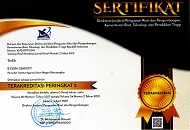Brief submission guideline:
- The journal invites scholars and experts working in all disciplines in education.
- Articles should be original, research-based, unpublished and not under review for possible publication in other journals.
- Manuscript should be typed in MS document format with Times New Roman, size 12 pts, one and a half space, A4 paper roughly 2000-8000 words. All manuscripts should be sent to Website : http://ecampus.iainbatusangkar.ac.id/ojs/index.php/takdib/index
- The article should be written in English, Arabic, or Indonesian. The title of the article is written in not more than 15 words. The title of the article, the name of its author or authors, email address, and institution are on the top of the article.
- All submission must include 100-250 words abstract and 3-5 keywords. The abstract of research paper should contain at least title, purpose, method, and research finding.
- Quotations, passages, and words in local or foreign languages should be translated into English.
- Full research papers should have broad relevance and contribute something new to Education. It includes:
Introduction: explains the theoretical background, related research, the practical applications and the nature and purpose of the article.
Methods: describes research type, the participants, the materials and the procedures employed in the study such as treatment(s) and data analysis.
Results and Discussion: Results should be clear and concise. Discussion should explore the significance of the results of the work, not repeat them. A combined Results and Discussion section is often appropriate. Extensive citations and discussion of published literature should be avoided.
Conclusion: The main conclusions of the study may be presented in a short conclusions section, which may stand alone or form a subsection of a discussion or Results and discussion section.
References: References are listed in alphabetical order. Each listed reference is cited in text, and Non-research papers include major theme, logical development of the theme, author's point of view, implications, inferences, or conclusions.
- References and notes should be written alphabetically as follows:
Flemming, L. E. (2011). Reading for thinking. Boston: Wadsworth Cengage Learning. ← Book
Linse, C. (n.d.). T.(2005). Practical English language teaching: Young learners. New York: McGraw-Hill. ← Book
Haviz, M. (2013). Research and development; penelitian di bidang kependidikan yang inovatif, produktif dan bermakna. Ta'dib, 16 (1), 28-42 ← Journal
Fitrisia, D., Tan, K.-E., & Yusuf, Y. Q. (2015). Investigating metacognitive awareness of reading strategies to strengthen students’performance in reading comprehension. Asia Pacific Journal of Educators and Education, 30, 15–30.←Journal
Hendriani, S. (2013). Developing a Model of Learning Strategy of Speaking English at College. International Review of Social Sciences and Humanit ies. www.irssh.com ←Journal
Hendriani, S. (2017). Teaching English For Specific Purposes (ESP) For Islamic Higher Education Studentd. PROCEEDING IAIN Batusangkar, 1(1), 701-710 ←Conferences
Hendriani, S., & Kustati, M. (2017). EFL students’ cooperation and creativity in using English grammar through poetry-based method. Proceedings of AICS-Social Sciences, 7, 646.←Conferences
Rahayu, J. S. (2015). Students’ reading engagement in literature circles a study of literature circles in teaching reading at a junior high school in bandung (masters). Universitas Pendidikan Indonesia. Retrieved from http://repository.upi.edu←Thesis
Lo, C-L. (2013). The impact of note-taking in counseling. PhD dissertation. The University of Iowa, Iowa City. ←Dissertation
Onukwugha, U. (2006). The Four Cardinal Points of Any Good Writing: Expression, Content, Organization & Technical Accuracy. Ezine Articles. Com, 28. Retrieved from http://ezinearticles.com/?The-Four-Cardinal-Points-of-Any-Good-Writing:- (Accessed 2 April 2014).←Website.
- All submitted papers are subject to review of the editors, editorial board, and blind reviewers.
- The editors reserve the right to reject manuscripts that are not in accordance with this guideline.
- All URL addresses in the text are activate.
- Author of articles published will receive freely one copy of journal and ten off-prints.
- The text address to the stylistic and bibliographic requirements outlined in the OUTLINE, which is found in About the Journal.
- The names and email addresses entered in this journal site will be used exclusively for the stated purposes of this journal and will not be made available for any other purpose or to any other party.
ON-LINE SUBMISSION
Author should fulfill the form as detail as possible where the star marked form must be entered. After all form textbox was filled, Author clicks on “Register” button to proceed the registration. Therefore, Author is brought to online author submission interface where Author should click on “New Submission”. The following are five steps in online submission process:
- Step 1 - Starting the Submission: Select the appropriate section of journal, i.e. Original Research Articles, Review Article, or Short Communication. Thus, author must check-mark on the submission checklists.
- Step 2 – Uploading the Submission: To upload a manuscript to this journal, click Browse on the Upload submission file item and choose the manuscript document file to be submitted, then click Upload button.
- Step 3 – Entering Submission’s Metadata: In this step, detail authors metadata should be entered including marked corresponding author. After that, manuscript title and abstract must be uploaded by copying the text and paste in the textbox including keywords.
- Step 4 – Uploading Supplementary Files: Supplementary file should be uploaded including Covering/Submission Letter, and Signed Copyright Transfer Agreement Form. Therefore, click on Browse button, choose the files, and then click on Upload button.
- Step 5 – Confirming the Submission: Author should final check the uploaded manuscript documents in this step. To submit the manuscript to Ta'dib journal, click Finish Submission button after the documents is true. The corresponding author or the principal contact will receive an acknowledgement by email and will be able to view the submission’s progress through the editorial process by logging in to the journal web address site.
After this submission, Author who submits the manuscript will get a confirmation email about the submission. Therefore, Author is able to track his submission status at anytime by logging in to the online submission interface. The submission tracking includes status of manuscript review and editorial process.


























